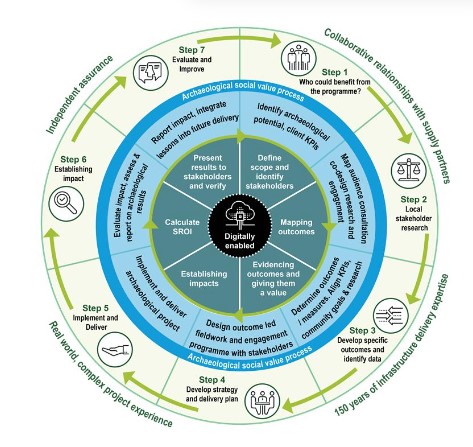Back to the future
Author: First published by the Institute of Environmental Management & Assessment - Dr Kate Faccia, Jeremy Galpin, Caroline Raynor, and Dr Sadie Watson report
How can we embed new value into developer-led archaeology?
In 1989, the discovery of the Rose Theatre in London’s Southwark set off events that directly affected the interface between British archaeology and development. Public demand for the preservation of the nationally historic playhouse site ushered in Planning Policy Guidance (PPG) 16, (now the National Planning Policy Framework 16) legislation that embedded archaeology in the planning process. PPG 16 required either preservation in situ or preservation by record of archaeological remains, as well as the ‘polluter pays’ principle, whereby developers are responsible for archaeological costs.
The evolution of historic environment policy dovetails nicely with social value legislation, first raised in the Public Services (Social Value) Act 2012. This act requires that publicly funded development demonstrates value for money and contributes toward increasing community resilience via social, economic and/or environmental variables that are generated beyond core deliverables. Archaeology is well suited to positively contributing to social value outcomes – it is a social science with the study of people at its heart. It contributes to placemaking, community identity, improved wellbeing, climate awareness and job opportunities. Research and practice now acknowledge that to achieve this, it is crucial to embed archaeology into the early stages of business cases and design phases. This inevitably requires new perspectives and an improvement in communication between archaeologists and developers to deliver meaningful social value and value for money.
Collaboration: an infrastructure roadmap
There is an increasing drive within the construction sector to embed social value and tangible outcomes for communities as part of major infrastructure projects. We are working with clients to identify how they define value on their projects and maximise outcomes, including social value. We define social value for infrastructure assets as the extrinsic and intrinsic impact of the asset on the wellbeing of society, throughout the asset’s lifecycle. In this context, there is an exciting opportunity to maximise the value added through the archaeology carried out on major projects – both the intrinsic value of the archaeological services required under the commissioned works and the extrinsic, or additional, value that can be added through the process, which is collaboratively developed on each scheme. The model, created in collaboration between Costain and Museum of London Archaeology (MOLA) social value teams, proposes a best-practice methodology for integrating social-value practice with archaeology and will form the basis of our recommended approach with all our customers.
MOLA is part of Costain’s specialist supply chain and regularly manages the delivery of complex archaeological schemes within major infrastructure projects. Our social value teams have joined forces to optimise the social-value output of major infrastructure projects by designing an interdisciplinary social-value methodology. Costain’s social-value model has been enhanced by MOLA colleagues to signpost the archaeological aspects of projects within the wider setting of project delivery. The various design, implementation and evaluation stages can all be perfectly aligned to archaeological comparators, and, if these steps are adopted as a business-as-usual approach, they will ensure positive outcomes, directed squarely at community recipients. This represents a great opportunity to enhance social value for all, using the archaeological outputs of projects as a core pathway. By placing archaeology and heritage front and centre from project inception, it ensures that no opportunities are overlooked.
The collaborative model (Figure 1) demonstrates how archaeological processes fit a typical project, and combines standard project design and implementation stages with a new way of thinking about social value. Legacy is at the heart of this new approach, ensuring that outcomes are appropriate and fit with the beneficiaries’ aspirations.

From Step 1, the aim is to understand the archaeological potential of a site and how we work with the client to identify their value targets. Step 2 demands we are cognisant of a wide variety of potential audiences and prompts an exploration of the audience demographic (often the local community and residents, but potentially drawing in other communities, such as teachers or an online interest group). Steps 3 and 4 are design-led and inform the archaeological project; consulting and co-design of a fieldwork strategy that targets outcomes at the communities identified in Step 2. The archaeological outputs (usually involving practical on-site fieldwork) at Step 5 will be conducted within the usual professional frameworks but with regular review stages built in to ensure that the intended legacy is kept at the forefront of method and practice. Step 6 is a new step for us – we always evaluate our archaeological results to assess their potential and significance for research, but it is also crucial that we assess the impact and outcomes we are intending to provide.
Evaluation methods will be project-specific, but archaeologists should fit with the client’s social-value outcome assessments to align with the project-value goals. Lastly, and importantly, Step 7 is the point of reflection and, in collaboration with the client and community beneficiaries, a chance to evaluate the degree to which the original aims have been achieved, and where changes need to be made to ensure further or repeat successes going forward.
Critically, this process includes external partners, clients and the wider community to stimulate a new approach to social value provision by archaeological practitioners within the wider planning system.
On recent projects, Costain and MOLA have collaborated to optimise the value delivered through archaeology, as well as offering other direct benefits to communities, archaeological professionals and construction sector employees. These include the Early Career Osteologists (ECO) scheme, supporting the next generation of archaeological experts, site tours and workshops for community groups and site tours to actively promote and educate construction site teams around the identification of archaeological sites and artefacts. This supports a proactive approach to the management of risks and opportunities associated with cultural heritage and has proven mental health and wellbeing benefits for those community groups and site personnel involved.



